KIA Borrego 2009 1.G Owner's Manual
Manufacturer: KIA, Model Year: 2009, Model line: Borrego, Model: KIA Borrego 2009 1.GPages: 425, PDF Size: 8.46 MB
Page 401 of 425

Maintenance48
7
Description Fuse rating Protected component
START7.5A Burglar Alarm Relay, Start Relay
AIR BAG IND. 7.5A Instrument Cluster (Air Bag IND.)
ABS 7.5AABS Control Module, ESC Control Module, DBC Relay, Steering Angle Sensor, Crash Pad Switch LH,
Smart Key Control Module, Rear Parking Assist Control Module
Rheostat, Instrument Cluster (MICOM), Multifunction Switch (Cruise Remocon), Generator,
IGN 1 7.5A Rear Parking Assist Buzzer, Rear Parking Assist Switch, Audio, PODS Module,
Tire Pressure Monitoring Module
ENG 7.5AMultipurpose Check Connector, ECM, TCM, Front Wiper Motor, 4WD ECM, Stop Lamp Switch,
Free Running Differential Air Pump, Generator (G8BA)
AIR BAG 15A SRS Control Module, Telltale Lamp
DDM 30A Driver Door Module, Driver Safety Power Window Motor
ADM 30A Assistant Door Module, Passenger Safety Power Window Motor
Page 402 of 425
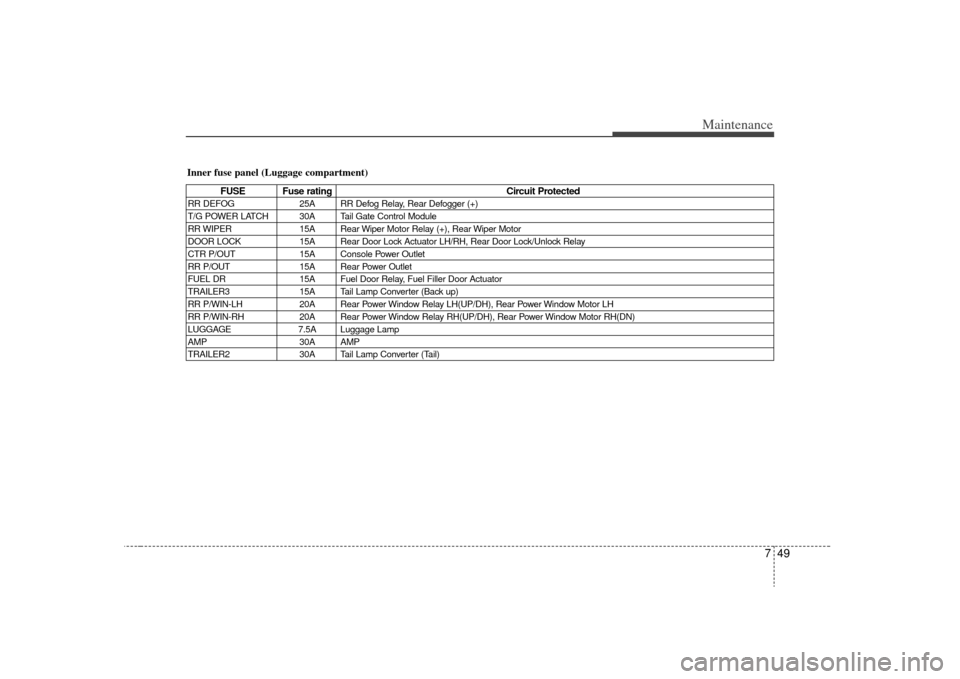
749
Maintenance
Inner fuse panel (Luggage compartment)
FUSE Fuse ratingCircuit Protected
RR DEFOG25A RR Defog Relay, Rear Defogger (+)
T/G POWER LATCH 30A Tail Gate Control Module
RR WIPER 15A Rear Wiper Motor Relay (+), Rear Wiper Motor
DOOR LOCK 15A Rear Door Lock Actuator LH/RH, Rear Door Lock/Unlock Relay
CTR P/OUT 15A Console Power Outlet
RR P/OUT 15A Rear Power Outlet
FUEL DR 15A Fuel Door Relay, Fuel Filler Door Actuator
TRAILER3 15A Tail Lamp Converter (Back up)
RR P/WIN-LH 20A Rear Power Window Relay LH(UP/DH), Rear Power Window Motor LH
RR P/WIN-RH 20A Rear Power Window Relay RH(UP/DH), Rear Power Window Motor RH(DN)
LUGGAGE 7.5A Luggage Lamp
AMP 30A AMP
TRAILER2 30A Tail Lamp Converter (Tail)
Page 403 of 425

Maintenance50
7Engine compartment main fuse panel
Description Fuse rating Protected component
FRT/RR WASHER 10A Front/Rear Washer Motor Relay, Washer Motor
TRAILER 5 15A Tail Lamp Converter (Turn/Stop)
STOP LAMP 20A Stop Lamp Switch, DBC Relay
KEY SW 1 25A Ignition Switch, PDM Relay Box (IG1 Relay , ACC Relay)
STOP SIGNAL 7.5A ABS Control Module, ESC Control Module, ECM, Smart Key Control Module
A/C COMP 7.5A A/C Comp Relay
FRT DEICER 15A Front Deicer Relay
HORN 15A Horn Relay
ECU 1 10A ECM, Mass Air Flow Sensor, Immobilizer Module, A/C Comp Relay
O2 DN 10A Oxygen Sensor #3,#4
ECU 2 15A Oil Control Valve, ECM, Variable Intake Manifold Valve, Purge Control Solenoid Valve, Canister Close Valve
O2 UP 10A Oxygen Sensor #1,#2
IGN COIL 20A Ignition Coil #1~#8, Condenser #1,#2
INJECTOR 15A ECM, Injector #1~#8, Camshaft Position Sensor #1 ~ #3 (G8BA)
P/TRAIN 7.5A ECM, Main Relay, Relay Box(Burglar Horn Relay), Generator (G8BA)
FUEL PUMP 15A Fuel Pump Relay, Fuel Sender & Fuel Pump Motor
ATM 15A TCM
Page 404 of 425
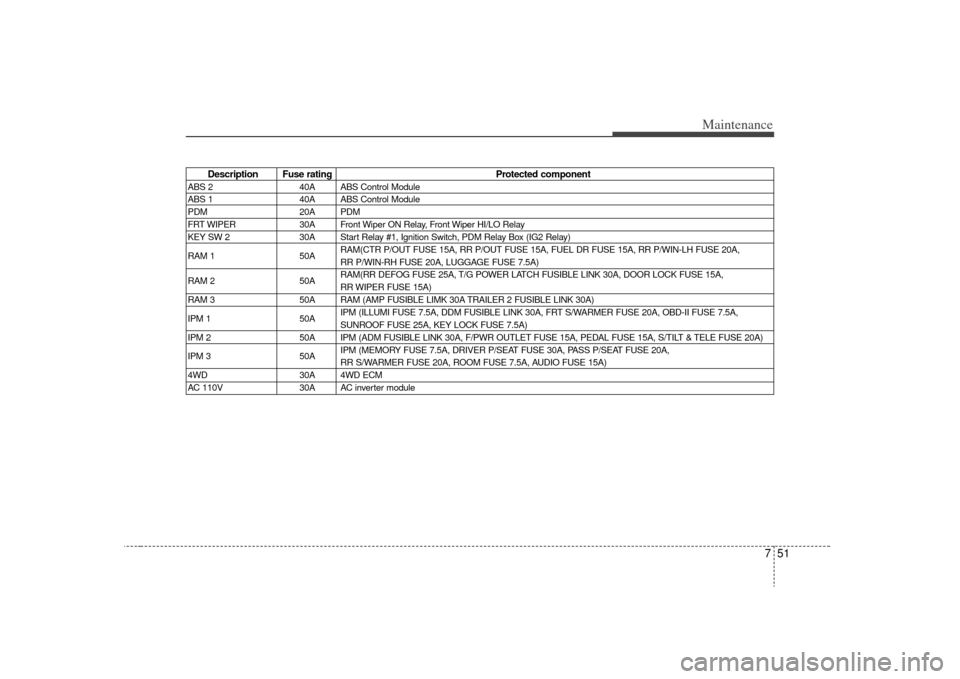
751
Maintenance
Description Fuse ratingProtected component
ABS 240A ABS Control Module
ABS 1 40A ABS Control Module
PDM 20A PDM
FRT WIPER 30A Front Wiper ON Relay, Front Wiper HI/LO Relay
KEY SW 2 30A Start Relay #1, Ignition Switch, PDM Relay Box (IG2 Relay)
RAM 1 50ARAM(CTR P/OUT FUSE 15A, RR P/OUT FUSE 15A, FUEL DR FUSE 15A, RR P/WIN-L\
H FUSE 20A,
RR P/WIN-RH FUSE 20A, LUGGAGE FUSE 7.5A)
RAM 2 50ARAM(RR DEFOG FUSE 25A, T/G POWER LATCH FUSIBLE LINK 30A, DOOR LOCK FUSE 15A,
RR WIPER FUSE 15A)
RAM 3 50A RAM (AMP FUSIBLE LIMK 30A TRAILER 2 FUSIBLE LINK 30A)
IPM 1 50AIPM (ILLUMI FUSE 7.5A, DDM FUSIBLE LINK 30A, FRT S/WARMER FUSE 20A, OBD-II FUSE 7.5A,
SUNROOF FUSE 25A, KEY LOCK FUSE 7.5A)
IPM 2 50A IPM (ADM FUSIBLE LINK 30A, F/PWR OUTLET FUSE 15A, PEDAL FUSE 15A, S/TILT & TELE FUSE 20A)
IPM 3 50AIPM (MEMORY FUSE 7.5A, DRIVER P/SEAT FUSE 30A, PASS P/SEAT FUSE 20A,
RR S/WARMER FUSE 20A, ROOM FUSE 7.5A, AUDIO FUSE 15A)
4WD 30A 4WD ECM
AC 110V 30A AC inverter module
Page 405 of 425
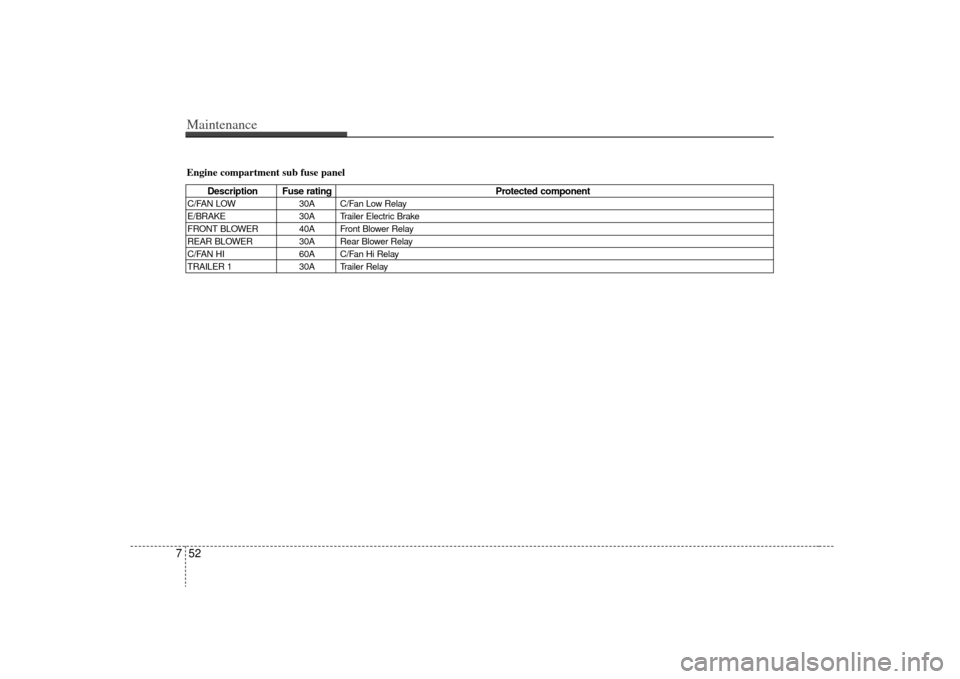
Maintenance52
7Engine compartment sub fuse panel
Description Fuse rating Protected component
C/FAN LOW30A C/Fan Low Relay
E/BRAKE 30A Trailer Electric Brake
FRONT BLOWER 40A Front Blower Relay
REAR BLOWER 30A Rear Blower Relay
C/FAN HI 60A C/Fan Hi Relay
TRAILER 1 30A Trailer Relay
Page 406 of 425
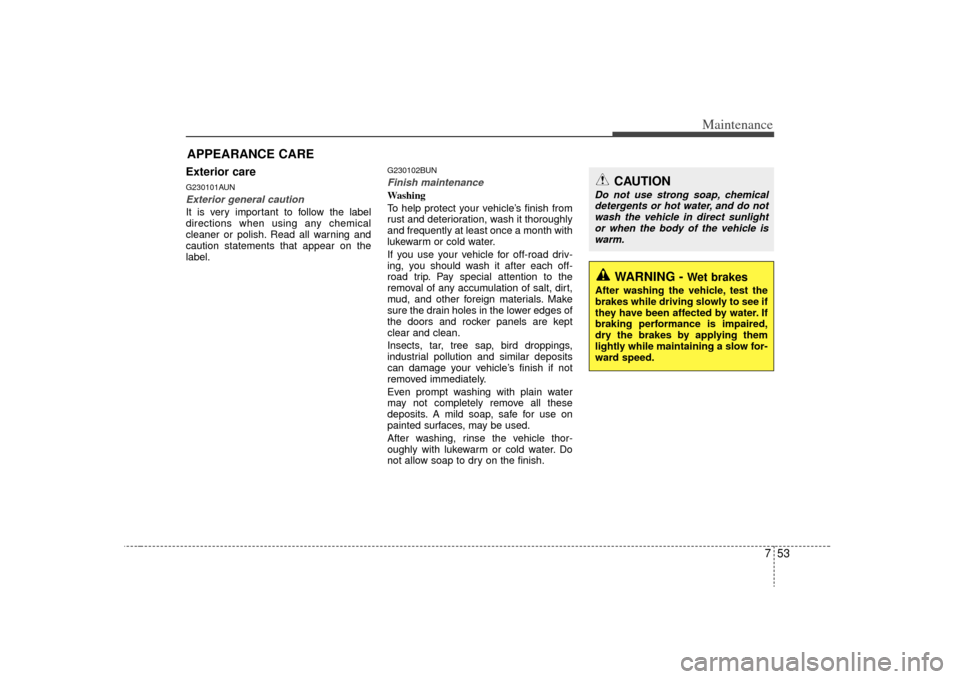
753
Maintenance
APPEARANCE CAREExterior careG230101AUNExterior general caution It is very important to follow the label
directions when using any chemical
cleaner or polish. Read all warning and
caution statements that appear on the
label.
G230102BUNFinish maintenanceWashing
To help protect your vehicle’s finish from
rust and deterioration, wash it thoroughly
and frequently at least once a month with
lukewarm or cold water.
If you use your vehicle for off-road driv-
ing, you should wash it after each off-
road trip. Pay special attention to the
removal of any accumulation of salt, dirt,
mud, and other foreign materials. Make
sure the drain holes in the lower edges of
the doors and rocker panels are kept
clear and clean.
Insects, tar, tree sap, bird droppings,
industrial pollution and similar deposits
can damage your vehicle’s finish if not
removed immediately.
Even prompt washing with plain water
may not completely remove all these
deposits. A mild soap, safe for use on
painted surfaces, may be used.
After washing, rinse the vehicle thor-
oughly with lukewarm or cold water. Do
not allow soap to dry on the finish.
CAUTION
Do not use strong soap, chemicaldetergents or hot water, and do notwash the vehicle in direct sunlightor when the body of the vehicle is warm.
WARNING -
Wet brakes
After washing the vehicle, test the
brakes while driving slowly to see if
they have been affected by water. If
braking performance is impaired,
dry the brakes by applying them
lightly while maintaining a slow for-
ward speed.
Page 407 of 425
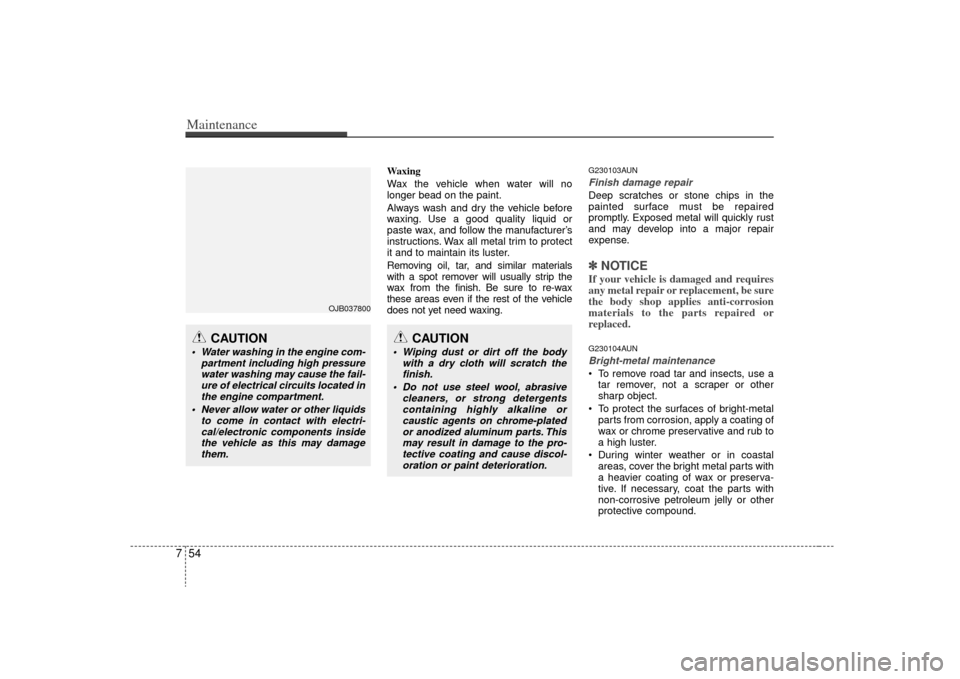
Maintenance54
7
Waxing
Wax the vehicle when water will no
longer bead on the paint.
Always wash and dry the vehicle before
waxing. Use a good quality liquid or
paste wax, and follow the manufacturer’s
instructions. Wax all metal trim to protect
it and to maintain its luster.
Removing oil, tar, and similar materials
with a spot remover will usually strip the
wax from the finish. Be sure to re-wax
these areas even if the rest of the vehicle
does not yet need waxing.
G230103AUNFinish damage repair Deep scratches or stone chips in the
painted surface must be repaired
promptly. Exposed metal will quickly rust
and may develop into a major repair
expense.✽ ✽
NOTICEIf your vehicle is damaged and requires
any metal repair or replacement, be sure
the body shop applies anti-corrosion
materials to the parts repaired or
replaced. G230104AUNBright-metal maintenance To remove road tar and insects, use a
tar remover, not a scraper or other
sharp object.
To protect the surfaces of bright-metal parts from corrosion, apply a coating of
wax or chrome preservative and rub to
a high luster.
During winter weather or in coastal areas, cover the bright metal parts with
a heavier coating of wax or preserva-
tive. If necessary, coat the parts with
non-corrosive petroleum jelly or other
protective compound.
CAUTION
Water washing in the engine com- partment including high pressurewater washing may cause the fail-ure of electrical circuits located in the engine compartment.
Never allow water or other liquids to come in contact with electri-cal/electronic components insidethe vehicle as this may damagethem.
CAUTION
Wiping dust or dirt off the body with a dry cloth will scratch thefinish.
Do not use steel wool, abrasive cleaners, or strong detergentscontaining highly alkaline or caustic agents on chrome-platedor anodized aluminum parts. This may result in damage to the pro-tective coating and cause discol-oration or paint deterioration.
OJB037800
Page 408 of 425
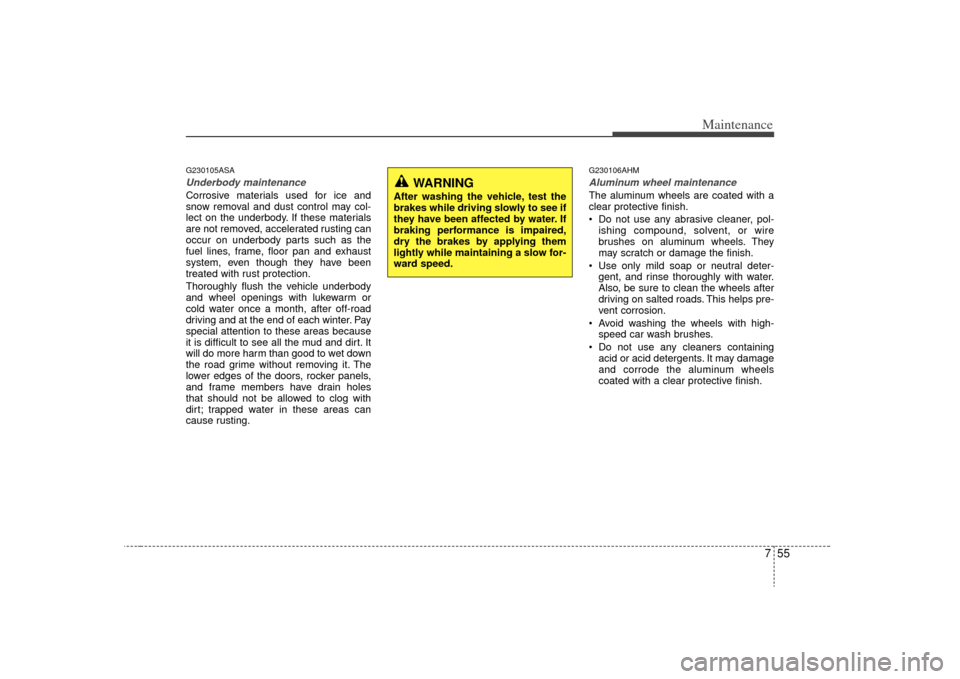
755
Maintenance
G230105ASAUnderbody maintenanceCorrosive materials used for ice and
snow removal and dust control may col-
lect on the underbody. If these materials
are not removed, accelerated rusting can
occur on underbody parts such as the
fuel lines, frame, floor pan and exhaust
system, even though they have been
treated with rust protection.
Thoroughly flush the vehicle underbody
and wheel openings with lukewarm or
cold water once a month, after off-road
driving and at the end of each winter. Pay
special attention to these areas because
it is difficult to see all the mud and dirt. It
will do more harm than good to wet down
the road grime without removing it. The
lower edges of the doors, rocker panels,
and frame members have drain holes
that should not be allowed to clog with
dirt; trapped water in these areas can
cause rusting.
G230106AHMAluminum wheel maintenance The aluminum wheels are coated with a
clear protective finish.
Do not use any abrasive cleaner, pol-ishing compound, solvent, or wire
brushes on aluminum wheels. They
may scratch or damage the finish.
Use only mild soap or neutral deter- gent, and rinse thoroughly with water.
Also, be sure to clean the wheels after
driving on salted roads. This helps pre-
vent corrosion.
Avoid washing the wheels with high- speed car wash brushes.
Do not use any cleaners containing acid or acid detergents. It may damage
and corrode the aluminum wheels
coated with a clear protective finish.
WARNING
After washing the vehicle, test the
brakes while driving slowly to see if
they have been affected by water. If
braking performance is impaired,
dry the brakes by applying them
lightly while maintaining a slow for-
ward speed.
Page 409 of 425
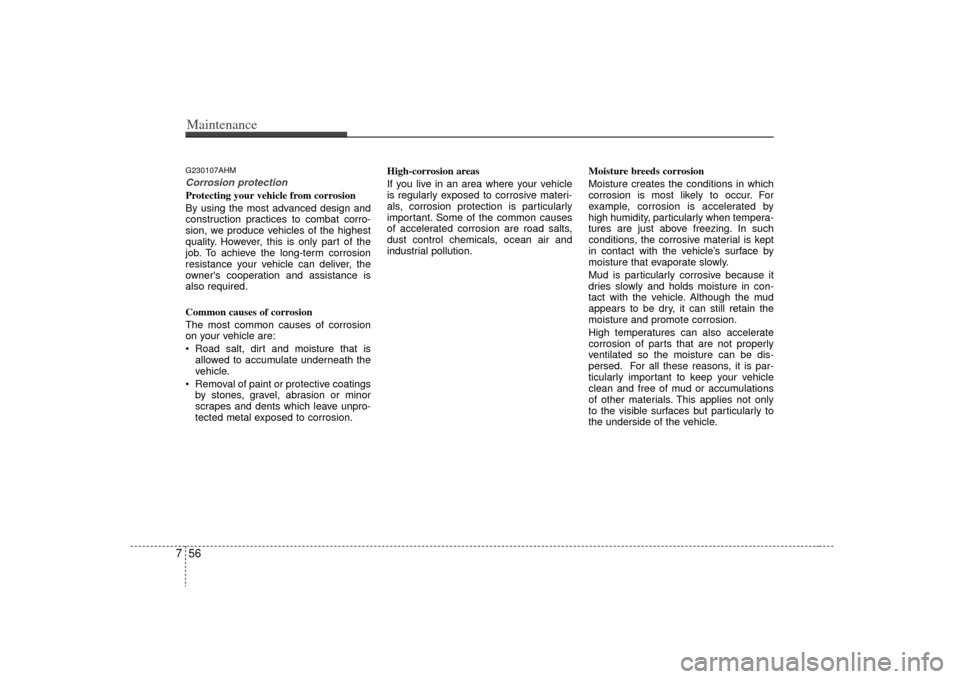
Maintenance56
7G230107AHMCorrosion protectionProtecting your vehicle from corrosion
By using the most advanced design and
construction practices to combat corro-
sion, we produce vehicles of the highest
quality. However, this is only part of the
job. To achieve the long-term corrosion
resistance your vehicle can deliver, the
owner's cooperation and assistance is
also required.
Common causes of corrosion
The most common causes of corrosion
on your vehicle are:
allowed to accumulate underneath the
vehicle.
Removal of paint or protective coatings by stones, gravel, abrasion or minor
scrapes and dents which leave unpro-
tected metal exposed to corrosion. High-corrosion areas
If you live in an area where your vehicle
is regularly exposed to corrosive materi-
als, corrosion protection is particularly
important. Some of the common causes
of accelerated corrosion are road salts,
dust control chemicals, ocean air and
industrial pollution.
Moisture breeds corrosion
Moisture creates the conditions in which
corrosion is most likely to occur. For
example, corrosion is accelerated by
high humidity, particularly when tempera-
tures are just above freezing. In such
conditions, the corrosive material is kept
in contact with the vehicle’s surface by
moisture that evaporate slowly.
Mud is particularly corrosive because it
dries slowly and holds moisture in con-
tact with the vehicle. Although the mud
appears to be dry, it can still retain the
moisture and promote corrosion.
High temperatures can also accelerate
corrosion of parts that are not properly
ventilated so the moisture can be dis-
persed. For all these reasons, it is par-
ticularly important to keep your vehicle
clean and free of mud or accumulations
of other materials. This applies not only
to the visible surfaces but particularly to
the underside of the vehicle.
Page 410 of 425
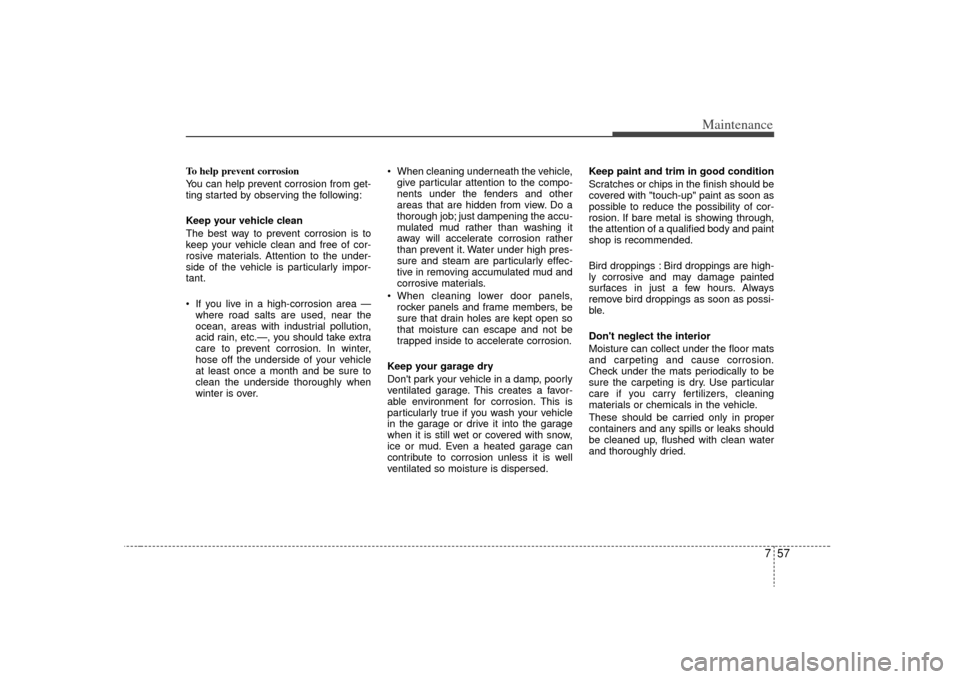
757
Maintenance
To help prevent corrosion
You can help prevent corrosion from get-
ting started by observing the following:
Keep your vehicle clean
The best way to prevent corrosion is to
keep your vehicle clean and free of cor-
rosive materials. Attention to the under-
side of the vehicle is particularly impor-
tant.
If you live in a high-corrosion area —where road salts are used, near the
ocean, areas with industrial pollution,
acid rain, etc.—, you should take extra
care to prevent corrosion. In winter,
hose off the underside of your vehicle
at least once a month and be sure to
clean the underside thoroughly when
winter is over. When cleaning underneath the vehicle,
give particular attention to the compo-
nents under the fenders and other
areas that are hidden from view. Do a
thorough job; just dampening the accu-
mulated mud rather than washing it
away will accelerate corrosion rather
than prevent it. Water under high pres-
sure and steam are particularly effec-
tive in removing accumulated mud and
corrosive materials.
rocker panels and frame members, be
sure that drain holes are kept open so
that moisture can escape and not be
trapped inside to accelerate corrosion.
Keep your garage dry
Don't park your vehicle in a damp, poorly
ventilated garage. This creates a favor-
able environment for corrosion. This is
particularly true if you wash your vehicle
in the garage or drive it into the garage
when it is still wet or covered with snow,
ice or mud. Even a heated garage can
contribute to corrosion unless it is well
ventilated so moisture is dispersed. Keep paint and trim in good condition
Scratches or chips in the finish should be
covered with "touch-up" paint as soon as
possible to reduce the possibility of cor-
rosion. If bare metal is showing through,
the attention of a qualified body and paint
shop is recommended.
Bird droppings : Bird droppings are high-
ly corrosive and may damage painted
surfaces in just a few hours. Always
remove bird droppings as soon as possi-
ble.
Don't neglect the interior
Moisture can collect under the floor mats
and carpeting and cause corrosion.
Check under the mats periodically to be
sure the carpeting is dry. Use particular
care if you carry fertilizers, cleaning
materials or chemicals in the vehicle.
These should be carried only in proper
containers and any spills or leaks should
be cleaned up, flushed with clean water
and thoroughly dried.